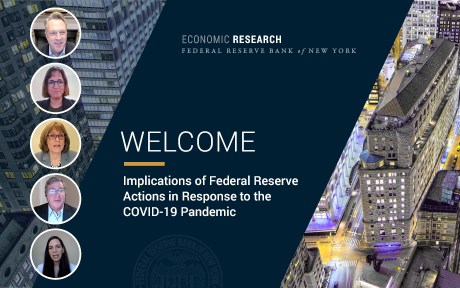
On September 30 and October 1, 2021, the New York Fed held a virtual conference on the implications of the Fed’s actions in response to the COVID-19 pandemic. New York Fed President John Williams gave the opening and concluding remarks.
Market Impact
The first session was moderated by Susan McLaughlin from the New York Fed’s Markets Group and focused on the market impact of the Fed’s response to the pandemic. Andy Haughwout, David Arseneau, and Or Shachar – all economists in the Federal Reserve System — presented research on the design and impact of the Fed’s interventions. Andy discussed a paper on the role of the Municipal Liquidity Facility, co-authored with Ben Hyman and Or Shachar, David presented work on the Main Street Lending Program, co-authored with Jose Fillat, Molly Mahar, Don Morgan, and Skander Van den Heuvel, while Or focused on the Primary and Secondary Corporate Credit Facilities, based on a paper co-authored with Nina Boyarchenko, Caren Cox, Richard Crump, Andrew Danzig, Anna Kovner, and Patrick Steiner. The New York Fed also released a series of Staff Reports dedicated to the facilities set up in response to the pandemic.
Watch the related conference video.
Financial Fragilities
The second session was on “Financial Ecosystem Fragilities Revealed by the Pandemic” and moderated by Beverly Hirtle, director of research at the New York Fed. First, Marcin Kacperczyk, from Imperial College London, talked about the consequences of global flows for financial stability. He also described research showing the benefits of swing pricing for open-ended mutual funds. Next, Arvind Krishnamurthy, from Stanford Graduate School of Business, discussed the fragility of bond markets and the implications for policy. Adair Morse, deputy assistant secretary for capital access at the Department of the Treasury, followed with an overview of small business finance and challenges to small firms during the pandemic. Finally, Stefan Nagel, from the University of Chicago Booth School of Business, discussed the dislocations that occurred in the Treasury market in March 2020.
Macroeconomic Impact
The third session, moderated by Andreas Lehnert, director of the Division of Financial Stability at the Federal Reserve Board, was on the topic of the macroeconomic impact of the interventions initiated in response to the pandemic. Markus Brunnermeier, from Princeton University, gave an overview of the financial dominance theory of monetary policy. Kinda Hachem, from the University of Virginia Darden School of Business, discussed differential trends in bank balance sheets across different bank sizes over the pandemic. Ricardo Reis from the London School of Economics, followed with a discussion of the role of central bank swap lines and the FIMA repo facility in helping to support the U.S. dollar as a global currency.
Lessons Learned
Lorie Logan, manager of the System Open Market Account (SOMA), moderated the fourth session on lessons for the future. Isabel Schnabel, executive board member of the European Central Bank, talked about the challenges faced by central banks in responding to events such as a pandemic. Hyun Song Shin, from the Bank for International Settlements, discussed the role of leverage in understanding threats to financial stability. Viral Acharya, from the New York University Stern School of Business, mentioned some steps that central banks could take to limit the risk posed by extreme events (for example, by limiting leverage in the financial system and addressing the proliferation of demandable claims). Finally, Thomas Philippon, from New York University’s Stern School of Business, provided some lessons from the global financial crisis and the pandemic, including the importance of debt guarantees, how best to restructure segments of the economy most affected by a shock, and the benefits of decentralizing shutdown decisions.

Nina Boyarchenko is a research officer in the Federal Reserve Bank of New York’s Research and Statistics Group.

Anna Kovner is the policy leader for financial stability in the Bank’s Research and Statistics Group.

Antoine Martin is a senior vice president in the Bank’s Research and Statistics Group.
How to cite this post:
Nina Boyarchenko, Anna Kovner, and Antoine Martin, “At the New York Fed: Implications of Federal Reserve Actions in Response to the COVID-19 Pandemic,” Federal Reserve Bank of New York Liberty Street Economics, October 15, 2021, https://libertystreeteconomics.newyorkfed.org/2021/10/at-the-new-york-fed-implications-of-federal-reserve-actions-in-response-to-the-covid-19-pandemic.
Disclaimer
The views expressed in this post are those of the authors and do not necessarily reflect the position of the Federal Reserve Bank of New York or the Federal Reserve System. Any errors or omissions are the responsibility of the authors.










 RSS Feed
RSS Feed Follow Liberty Street Economics
Follow Liberty Street Economics